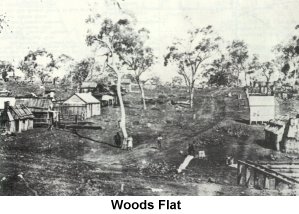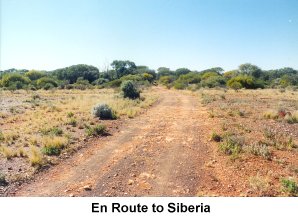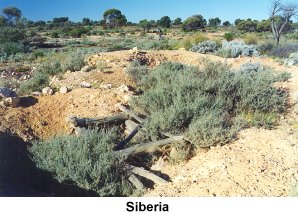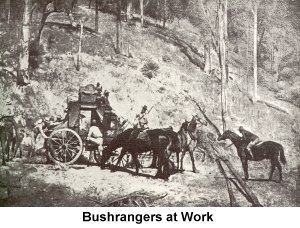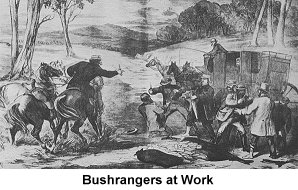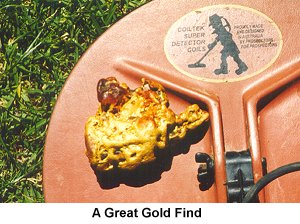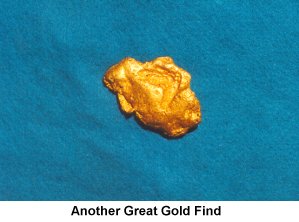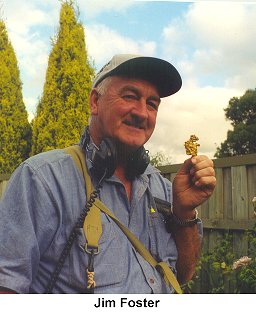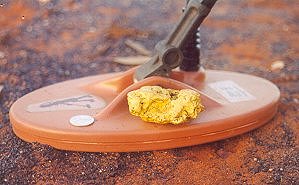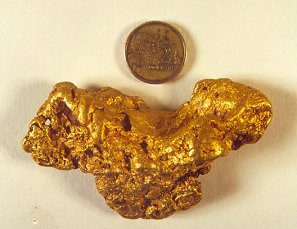
| November 2001 | |||||||||||||||||
|
|||||||||||||||||
Contents
|
|||||||||||||||||
1. EDITORIAL I start with another reminder that we do require a real email address when you subscribe. We have given previous undertakings that email addresses will not be on sold under any circumstances. However where email addresses are not corrrect access will be denied. Our gold sales into the US are progressing well - with more markets developing all the time. As time goes by - development of these markets certainly allows for cash flows to prospectors to improve as the US is still performing well with gold sales. It seems that recent world events have stimulated interest in gold. Speaking with Phil Stearns this week regarding the new Garrett Metal Detector it seems that the security business within the US is booming for Garrett Metal Detectors and this has caused a delay in the release of the new Garrett metal detector. We are always interested in new and innovative products that will assist prospectors in gold recovery. Understandably - we may have to wait a little longer before this new detector hits the market here. Interest in the Gold Expo had again been excellent and we can look forward to another outstanding event with even more exhibitors expressing a desire to attend. Support from the PMAV and APLA will again be forthcoming. We can all look forward to another outstanding event.
A week ago my main email server collapsed financially and for several days Gold Net was unable to collect emails - and some may have been returned unclaimed. If you did forward an email and this occurred my profound apologies, but on occasions this happens in the vaguaries of business. Editor Email: [email protected]
All material in this magazine is copyright and may not be reproduced in any part or form whatsoever without written permission from the publisher.
|
|||||||||||||||||
2. WOODS FLAT N.S.W.
 by Brad Williams woods Flat lies close to 200 kilometres due west of Sydney, near the rural city of Cowra, which lies on the great Lachlan River. These days it is a quiet place. The history of this area is in many respects similar in that the origins of white settlement relate to agricultural pursuits. Initially it seems that as far back as 1815 white men first visited this region and from that time squatters began to settle the land in this area. Bringing with them breeding sheep and cattle, they were the pioneers of this productive area, and quickly took up the best land. Gold was not considered in this area even through the heady days of the great gold rushes in Victoria and in New South Wales, when all and sundry were looking for the yellow colour. In fact the records are not clear in just when in 1868, gold was discovered, but it was almost certainly during the winter, and about the time that gold was found at Hill End. This does not mean that gold was not known to be here previously - it was just not promulgated.
The gold at Woods Flat, was deep and hard to get and at this time, alluvial gold was still being found all over New South Wales and Victoria, and diggers, looking for easier pickings moved on. Much of the gold was contained in reefs at about 100 feet deep, and gold recovery was in such circumstances not immediately recoverable without considerable effort and expense. Surface gold was in minimal quantities at Woods Flat, which is probably why the gold field was not well supported by diggers. The digging of shafts was a dangerous occupation, and the search for gold often resulted in shafts being dug without timber supports being used in the rush to find pay dirt. Many accidents occurred as a result often resulting in deaths. However when pay dirt was found many of the shafts were supported with timber to ensure safety of the diggers. Mining at these depths was usually carried out using a simple windlass over the shaft. More sophisticated methods of pay dirt extraction does not appear to have been used here, other than the use of a horse to lift the buckets with the pay dirt. Perhaps this occurred because of the smaller scale of the operations. Puddlers were used to extract the gold - but as this area has a lot of clay the recovery process was slow and laborious. These were usually constructed and owned and operated by men who took a percentage of the gold recovered as payment for the use of the puddler. Very few puddlers appear to have been in use at Woods Flat.
The reef gold was extracted by the use of stampers. Most of the crushed rock was washed twice to extract the gold through the sluicing methods of gold recovery. Perhaps the greatest period of gold recovery from Woods Flat was reported in 1874, when one group reported 1,000 ounces and another reported 2,500 ounces. However other finds in other nearby gold fields created interest that took miners and mining companies to other nearly gold fields. The Woods Flat gold field had a relatively long and chequered history, with several companies re-visiting the gold field from time to time to find the illusive reefs that seemed to hide the real treasure, that proved over many years to be so hard to find and then follow successfully. Just how much gold was extracted from the Woods Flat gold field is very hard to determine, but over the total of years that gold was recovered successfully it was a considerable amount. Just how much is not known, as official records are incomplete and of course you have the undeclared gold finds that distort official figures. Today almost nothing remains of the buildings at Woods Flat. Landowners over many years have demolished the old buildings - perhaps to hide the old gold field to today's prospectors. In any case, the old gold field is no longer, but no doubt where old gold fields existed in the past, there is sure to be gold.
|
|||||||||||||||||
|
|||||||||||||||||
3. THE SIBERIAN DISASTER by Sue "Goldie" Reynolds As we all know, Siberia is a long way from anywhere, is remote and has a reputation for harsh conditions. The Siberia of the gold fields of Western Australia, in the 1890's, inherited the name for similar reasons. An extremely harsh environment that in fact was to turn into a total disaster for many prospectors. The Western Australian Siberia is located some 120 kilometres north,n orth west, of Coolgardie, in the barren desert region of the great gold fields of W.A. In 1893 it was a lonely forbidding and dry place. Over 100 years later, little has changed. It is still a dry and desolate place. William Frost and Robert Bonner, two prospectors who were well known in the area, reputedly found the first gold at Siberia. When word reached Coolgardie a rush began. However this rush was to prove a disaster for some and a near disaster for others. Although not all that far from Coolgardie, with so many diggers proceeding on foot into a desolate region, which was known to lack water, a disaster was in the making.
Gold fever can be a powerful driving force - and this rush would not be the first time that men had thrown caution to the wind for the hope of finding a bonanza of gold. As the men left to walk to the Siberian Gold Field, some were warned that there was a stretch of about 70 miles where no water was available. With scant water reserves the men set off. Renou, who was taking steps to supply water along the track as best he could. Upon reaching Moorowing, to the northwest, he warned the 600 plus diggers he found there, that there was no water there, or on the way, and they should not proceed, but return to Coolgardie. Most of this advice, as sound as it was, was ignored. Water tanks were placed along the track that led north at intervals of about 20 miles, and when men were located they were advised that water would be place on the tracks at those intervals - but would be removed early in November, and after that men would be responsible for their own actions. Renou was concerned, as he reported that be believed that a number of deaths has already occurred, perhaps up to 10, and reports were coming in that up to 400 may have perished. However, from his experience be believed that these reports were mischievous - and proclaimed that.
Many men had camped at the 35-mile soak, and the one man in charge has been overwhelmed by the 600 plus men who simply took the water. The water warden at the soak called a meeting. After consultation he make several decisions to push water further towards the rush, using camels. However - his orders were to give men relief who were returning to Coolgardie - not to supply men to travel towards the gold field at Siberia. Humanitarian considerations took over in some instances and men were supplied to ensure they did not perish. Diggers had gone in all directions seeking the gold field, with very little consideration being given to the re-supply of water. The water wardens were doing their best to find thirsty men and provide them with water, but many had walked off into the bush looking for the gold field, and they were apparently all over the place, moving off in different directions.
The next day, Armitage left the Siberian Gold Field, heading for Coolgardie. Along the way, many on foot, heading for Coolgardie, were given water to ensure their survival. Four days later he arrived back in Coolgardie. The common sense of men like Armitage and Renou, who, without question relieved a particularly difficult situation in the bush in the spring of 1893. The gold at Siberia was contained generally in a very small area, measuring only about 500 feet by 50 feet wide, and was quickly exhausted. At the time, the diggers considered this rush a "duffer", but in reality the Siberian area produced well over 100,000 ounces of gold.
Just how many diggers perished on the way to Siberia is not recorded.
It may well be that none perished at all - but it is more likely that some did perish, although official records cannot confirm this.
|
|||||||||||||||||
|
|||||||||||||||||
4. BUSHRANGER BUNGLES by Laurelle Murphy
The history of Bushranging in Australia during the great gold era has to a large extent been lost. No doubt historical records still exist in the archives and someday the real story of the bushrangers might be told. Some of the bushrangers were highly intelligent and there were those among them who were "gentleman" bandits, who although they robbed their fair share, they displayed an attitude that earned them some sort of respect from those they robbed. On the other hand there were several whose brutality was legendary. Many a lonely traveller, moving alone through the bush was murdered for a few trinkets, and it is sad to say - large numbers of these murders were never reported, let alone investigated.
A Chinaman in western New South Wales decided that bushranging seemed to be a profitable enterprise so he set about obtaining a pistol and held up a number of unsuspecting travellers on the road near Coonabarabran.
The local police officer, Constable Ward, upon hearing of these hold-ups soon picked up the trail and followed the Chinaman into the bush. One could be forgiven for believing that Jackey Jackey was an aboriginal bushranger. This was not so. In fact his real name was William Westwood, and he was transported as a juvenile in 1837 at the age of 16, and although working on a farm within three years turned to bushranging in company with a brutal man called Paddy Curren. Curren treated woman badly when he was robbing them and the partnership was short lived when Curren overstepped the mark during one robbery and violated a woman. Jackey Jackey took to Curren, stripped him of his weapons, ammunition, his horse and food, and threatened to shoot him. His reputation as a gentleman bandit was enhanced as a result.
Charles Rutherford, a notorious bushranger from the Bathurst district of New South Wales, had been sentenced to 7 years imprisonment for his misdeeds, and in company with other prisoners was being transferred to Sydney, by Cobb & Co stage. It was a large coach - with a total of 15 prisoners inside, chained in groups of 7 and 8 respectively. Two unarmed police officers rode inside the coach and there were 5 fully armed mounted troopers, and a sergeant who rode with the driver. When the coach stopped near Pulpit Hill, the prisoners' together made a daring attempt to escape. During the melee one of the police officers was killed, and Rutherford with another prisoner made good his escape.
He quickly returned to his bushranging. Seven months later, he was captured by Sergeant Cleary of Bourke. However, he again escaped and a month later held up and robbed the Boggy Creek, and Galathera Inns. From here he made his way to the Inn at Cannonbar. The Inn keeper was ready for any bushranger, and kept a loaded pistol in his till.
Some of the acts of courage displayed by some who were held up - perhaps needs some mention. There are many, but one that comes to notice quickly, is the bank teller at Cassilis, who was dutifully recording transactions when he lookup up to see a bushranger standing before him with a pistol pointing at his head. The bushranger demanded, "bailup - or I'll blow your brains out".
The era of bushranging in the gold fields was a long, detailed, and in fact a rather sad episode in the history of this new land. A rapidly growing country, with very little government infrastructure to properly administer the burgeoning nation, was struggling on many fronts to address the lawlessness. It should be said, however, that if one studies records, the punishments handed out in most cases, were to a large extent expected. Murderers, if convicted, forfeited their lives. Robbers were generally imprisoned for several years. In general the rule of law, although not always perfect was accepted to the population as being appropriate.
This was a colourful time in the history of this nation, and one that has not been recognised as well as it might have been.
|
|||||||||||||||||
|
|||||||||||||||||
|
5. NEW DIRECTIONS  by Craig Wilson The gold prospecting industry is clearly at the crossroads. Without doubt many participants have been re-assessing their commitment to their hobby, or in the case of serious prospectors who rely on finding gold for a living, their on going commitment to remaining within the industry. Since the early 1980's this industry has been growing and in fact positively flourishing. In the last year or two the positive developments and giant leaps ahead with technology that impressed and excited us all, appear to have levelled out, and our expectations of giant leaps forward are not coming to fruition.
However, if we do look at some facts that are not always seen by the amateur detectorist, we view the industry in a different light.
Larger nuggets, are of course not as prolific, but none the less, are being regularly pulled from the dirt in both the Golden Triangle and the Golden West gold fields. If you were at the Gold Expo at Ballarat last year, and you knew where to look, you would have seen a fabulous array of larger nuggets, many in the 40-ounce range. There is no doubt that they are still there. Perhaps we simply do not recognise that they are there in the numbers that are evident to gold buyers, who I might add, are notoriously silent about their dealings etc. and rightly so. But in the future, just what direction will the industry take to ensure survival? The future in the Victorian Gold Fields does not look promising with the Government, through the ECC restricting the Box Iron Bark Forests, which contains most of the recoverable gold sources. Alternately in Western Australia there are positive signs that gold prospecting is being positively encouraged. Perhaps APLA did not achieve exactly what it set out to achieve but it certainly opened up the gold fields throughout the Golden West. It appears however, that governments per se will not generally alter their policy on fossicking, across the board. The use of hand held implements seems to be the only way we as prospectors, will be able to access the available surface gold. In the future no doubt, access to land will be even harder and further restrictions placed on us. In real terms, gold recovery has perhaps only a further 20 years to run with the present development rate of technology. At least this is the view of such respected players as Doug Stone, and several other experts, who have been associated with the industry since its birth 20 plus years ago. In gleaning information from major players within the industry, it appears that although talked about, the giant leaps forward in technological advances are not coming to fruition. Coiltek, that inventive organization in Salisbury, South Australia, has made significant improvements to the SD range of Minelab Detectors, through intuitive development of a quality range of coils that had crept ever deeper into the gold bearing ground. In speaking with John Kah this last week, the CEO at Coiltek, his belief is that in the foreseeable future - like 2 years or so, improvements will be made by refining the available technology, and with larger, lighter and purpose built coils, more gold will be recovered. However, it is unlikely that giant leaps forward will be made within this period, unless there is a major break through in technology that allows the detectorist to find gold by a completely different method than that presently being used by most detector manufacturers.
Finding gold is becoming harder, there is no doubt about that. Gold reserves are still there, in the ground, just waiting for that break through in technology that will allow us to reap more rich rewards.
Undoubtedly we are still some distance away from the time when we have a detector with a screen that peers into the depth of the earth, and shows us all the dirt, rocks, and gold at specific depths, on a LCD display. We should never give up the eternal search for new technology, and those who are manufacturers, should not give up their Research and Development. It is always a battle to find enough dollars to complete more research and development to achieve a positive and profitable result. Australians are inventive people, and many of the players in the industry are indeed highly talented and intuitive characters, who I believe will find the great leaps forward that we need to ensure the future of the prospecting fraternity.
|
|||||||||||||||||
|
|||||||||||||||||
6. JIM FOSTER'S NEW BOOK by Brad Williams Jim Foster has for over 20 years been involved in the detecting industry. It is indeed a great hobby of Jim and his delightful wife Cheryl that has seen them travel all over Australia detecting. Both are highly qualified detectorists and their knowledge is second to none in this field. But Jim does not just enjoy his detecting - he is also an accomplished writer. As well as writing extensively for Gold Gem And Treasure, Jim also writes for a number of other publications, particularly those relating to travelling the outback and spending time in the great out doors in this wide vast land. For some years Jim has been researching and collecting material with the object in mind of writing a book about the gold field adventures of the Chinese who came here to find their fortunes. Finally after many years of research, the book was released last month. The story is based on historical facts, relating to the great exodus the Chinese made from their homeland to the great southern land - where they believed there was gold for the taking. Little did most of these Chinese realise that in fact this land was a real golden bonanza, and many of them would make their fortunes here. The story follows the adventures of Xiang, a young orphan who resides in a rural village with his grandparents. His true love Soo Chin Lee, who he desires to marry, is promised to Ah Wang the son of the wealthiest man in the village. Xiang's grandfather works on a plan for the young orphan to travel to "The New Gold Mountain", where he might make his fortune, and return within the year to rescue his love, from the clutches of the brutal Ah Wang.
Their arrival in the great southern land was plagued with mishaps en route, great sea storms and shipwrecks. Although safe, Xiang and his compatriots were still a long way from the gold fields. Their epic and long journey overland towards the gold fields, interspersed with many encounters along the way, and the traumatic events of the era. Enroute to the great known gold fields, then try their luck and eventually hit the great gold bonanza that many dream about. Holding onto their gold proves to be a difficult task in this vast and lawless land, and there are many adventures in the gold fields that keeps you reading chapter after chapter.
Eventually with a fortune in gold in his possession Xiang and his friend begin the long journey to their homeland and to save his beloved Soo Chin Lee. The book is suitable for all ages and certainly follows the historical events of this golden era in detail. The characters, although fictitious, add life to this delightful and easy to read narrative. The book "Xiang And The New Gold Mountain" can be purchased from Jim Foster direct. The cost is just $12.50, which includes packaging and postage.
You can : Email Jim To obtain your autographed copy now.
|
|||||||||||||||||
|
|||||||||||||||||
7. FLECKS ! - Glints from here and there
|
|||||||||||||||||
|
From time to time we come across products that are beneficial to the serious prospector. When we do we will bring these products to attention. Recently we came across a set of scales that not only are extremely accurate - dthey weigh up to 250 grams, that is 8 ounces or so, and are very competitively priced. In the past most of us struggled along with scales of various makes that generally cost us quite a bit of loot, and then only weighed about 100 grams, of just over 3 ounces. To the serious prospector scales are an essential piece of equipment, as having found gold - one must know exactly the weight to .1 of a gram - to ensure correct payment is made when selling the gold. We have found The Pointscale 250 to be an outstanding product. It weighs in grams, ounces, ounces troy, and dwt. A simple press of a button alters the mode to weight in different categories. When you turn on the scale it takes a short time to stabilize - about 30 seconds in fact. Perhaps the best feature of this scale is that it is capable of recalibration. A great feature to ensure total accuracy.
The scale comes with batteries fitted and has a one year guarantee. It looks, and is robust, although it is
a precision instrument - and should always be treated as such.
|
|||||||||||||||||
|
|||||||||||||||||
8. STRIKES Recent Finds
|
|||||||||||||||||
|
|||||||||||||||||
|
9. THE NEW LODE - Next Month's Issue
|
|||||||||||||||||
|
|||||||||||||||||
